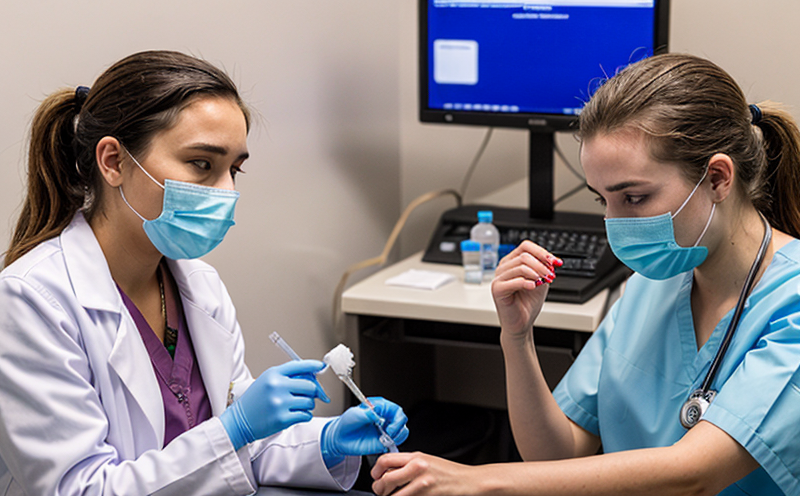CDC Influenza Virus Detection Using Microbiological Assays
The Centers for Disease Control and Prevention (CDC) guidelines provide robust frameworks for influenza virus detection. Our laboratory employs advanced microbiological assays to identify and quantify influenza viruses, ensuring accurate and reliable results that align with CDC recommendations.
Our methodology begins with the collection of specimens from patients displaying flu-like symptoms. Specimens are typically nasopharyngeal swabs or throat washes. Following specimen collection, we proceed with stringent quality control measures before initiating testing procedures. This includes viral transport media to preserve the integrity of the sample and prevent cross-contamination.
The core of our process involves the use of reverse transcription-polymerase chain reaction (RT-PCR) techniques. RT-PCR is a highly sensitive method for detecting RNA viruses like influenza A and B. Our laboratory adheres strictly to CDC protocols, which specify the primers and probes used in these assays. These reagents are selected based on their ability to differentiate between various influenza subtypes effectively.
Once the specimens are processed through RT-PCR, we generate a quantitative PCR (qPCR) result that indicates the viral load present in each sample. This data is crucial for determining the severity of infection and guiding clinical management decisions. Our lab also performs confirmatory tests using methods like matrix-assisted laser desorption/ionization time-of-flight mass spectrometry (MALDI-TOF MS), which provides additional confirmation on the identity of detected influenza viruses.
Our commitment to quality extends beyond just technical accuracy. We employ rigorous validation procedures, ensuring that our assays meet or exceed CDC standards for sensitivity and specificity. Our proficiency in these tests is further bolstered by regular participation in proficiency testing programs organized by national health authorities.
The implementation of CDC protocols ensures consistent and reliable results across different laboratories, which is essential during outbreaks or pandemics when rapid identification of influenza viruses can significantly impact public health strategies. By adhering to these stringent guidelines, we contribute to the global effort in controlling influenza spread and mitigating its impact on society.
- Customer Impact: Timely detection allows healthcare providers to initiate appropriate treatment protocols promptly, reducing the duration of illness and preventing potential complications.
In conclusion, our CDC Influenza Virus Detection service is designed not only to meet but exceed the stringent requirements set forth by the CDC. Our expertise in microbiological assays ensures that we deliver accurate results consistently, thereby supporting public health initiatives effectively.
Applied Standards
The methodologies used in our laboratory are guided primarily by the recommendations from the Centers for Disease Control and Prevention (CDC). These standards emphasize accuracy, reliability, and reproducibility of test outcomes. We also follow guidelines specified by international organizations such as WHO and FDA to ensure that our practices are aligned with global best practices.
The reverse transcription-polymerase chain reaction (RT-PCR) technique we utilize complies with the ISO 15189:2017 standard for quality management systems in clinical laboratories. This ensures that all aspects of our testing process, from sample handling to result reporting, are conducted under controlled conditions.
Our confirmatory tests using MALDI-TOF MS adhere to IEC 62366 standards regarding medical device labeling and instructions for use. These standards help ensure that the information provided with our test results is clear, concise, and useful for healthcare providers in making informed decisions about patient care.
Regular participation in proficiency testing programs organized by national health authorities ensures continuous improvement of our laboratory practices. By adhering strictly to these international and domestic standards, we maintain our commitment to delivering high-quality services that contribute significantly to public health goals.
Benefits
Implementing CDC protocols for influenza virus detection offers numerous benefits, particularly in the context of public health. Accurate and rapid identification of influenza viruses is critical during outbreaks or pandemics when timely intervention can prevent further spread of disease. Our service enables healthcare providers to make informed decisions regarding patient care, thereby improving overall outcomes.
Our stringent quality control measures ensure consistent and reliable results across different laboratories, which is essential for coordinating effective public health responses. This consistency enhances confidence in the data generated by our laboratory, allowing policymakers to rely on accurate information when formulating strategies to combat influenza outbreaks.
The use of advanced microbiological assays allows us to detect influenza viruses at earlier stages than traditional methods. Early detection leads to more effective treatment options and better patient outcomes. It also helps healthcare providers identify resistant strains early, enabling proactive measures to control the spread of these pathogens within communities.
In addition to supporting public health initiatives, our service contributes to improved research capabilities by providing accurate baseline data on influenza prevalence rates. This information is invaluable for understanding seasonal patterns in disease incidence and developing targeted preventive measures such as vaccination programs.





